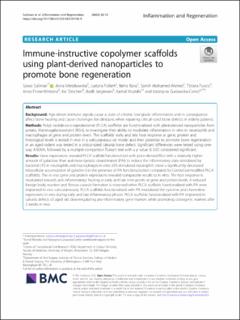Immune-instructive copolymer scaffolds using plant-derived nanoparticles to promote bone regeneration
Suliman, Salwa; Mieszkowska, Anna; Folkert, Justyna; Rana, Neha; Mohamed-Ahmed, Samih Salah Eldin Mahgoub; Fuoco, Tiziana; Finne-Wistrand, Anna; Dirscherl, Kai; Jørgensen, Bodil; Mustafa, Kamal Babikeir Elnour; Gurzawska-Comis, Katarzyna
Journal article, Peer reviewed
Published version

Åpne
Permanent lenke
https://hdl.handle.net/11250/3038669Utgivelsesdato
2022Metadata
Vis full innførselSamlinger
Sammendrag
Background
Age-driven immune signals cause a state of chronic low-grade inflammation and in consequence affect bone healing and cause challenges for clinicians when repairing critical-sized bone defects in elderly patients.
Methods
Poly(L-lactide-co-ɛ-caprolactone) (PLCA) scaffolds are functionalized with plant-derived nanoparticles from potato, rhamnogalacturonan-I (RG-I), to investigate their ability to modulate inflammation in vitro in neutrophils and macrophages at gene and protein levels. The scaffolds’ early and late host response at gene, protein and histological levels is tested in vivo in a subcutaneous rat model and their potential to promote bone regeneration in an aged rodent was tested in a critical-sized calvaria bone defect. Significant differences were tested using one-way ANOVA, followed by a multiple-comparison Tukey’s test with a p value ≤ 0.05 considered significant.
Results
Gene expressions revealed PLCA scaffold functionalized with plant-derived RG-I with a relatively higher amount of galactose than arabinose (potato dearabinated (PA)) to reduce the inflammatory state stimulated by bacterial LPS in neutrophils and macrophages in vitro. LPS-stimulated neutrophils show a significantly decreased intracellular accumulation of galectin-3 in the presence of PA functionalization compared to Control (unmodified PLCA scaffolds). The in vivo gene and protein expressions revealed comparable results to in vitro. The host response is modulated towards anti-inflammatory/ healing at early and late time points at gene and protein levels. A reduced foreign body reaction and fibrous capsule formation is observed when PLCA scaffolds functionalized with PA were implanted in vivo subcutaneously. PLCA scaffolds functionalized with PA modulated the cytokine and chemokine expressions in vivo during early and late inflammatory phases. PLCA scaffolds functionalized with PA implanted in calvaria defects of aged rats downregulating pro-inflammatory gene markers while promoting osteogenic markers after 2 weeks in vivo.
Conclusion
We have shown that PLCA scaffolds functionalized with plant-derived RG-I with a relatively higher amount of galactose play a role in the modulation of inflammatory responses both in vitro and in vivo subcutaneously and promote the initiation of bone formation in a critical-sized bone defect of an aged rodent. Our study addresses the increasing demand in bone tissue engineering for immunomodulatory 3D scaffolds that promote osteogenesis and modulate immune responses.
